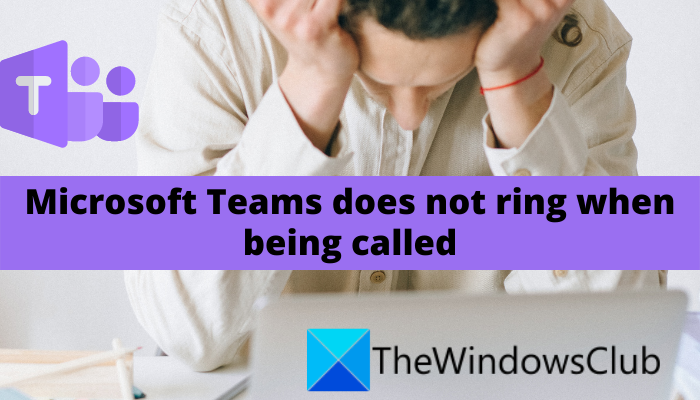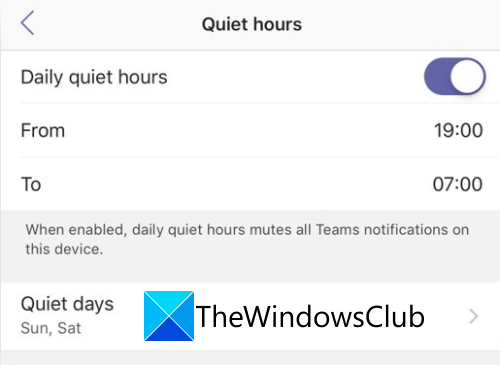Are Microsoft Teams Calls not ringing? Here is a complete guide that will help you if Microsoft Teams does not ring when being called. Many Teams users have complained of being unable to get the sound notification of incoming calls on their desktop app. Due to the issue, the users might miss out on important calls when using the desktop Microsoft Teams app. Now, if you are one of the affected users, you can try the fixes we have mentioned to get rid of this problem.

Why does my Teams not ring when I get a call?
There can be different reasons for your Teams not ringing when being called. Here are some of the potential causes:
- The problem might be caused if the output sound is not working on your system generally. So, make sure the audio is working fine on your PC by playing an audio file.
- If you are not connected to a stable internet connection, it might cause the issue at hand. Hence, ensure that there is no internet issue and you are connected to a stable network connection.
- You might encounter the issue if your license type or agreement is not as per the requirement for receiving calls on Teams.
- If your call notification setting is not configured rightly, you are likely to get the issue at hand. In that case, you can set up the call notifications setting to fix the issue.
- Your Quiet Hours settings on your mobile app might also interfere with your desktop app. So, try disabling or changing the Quiet Hours settings and see if the issue is fixed or not.
- In case your Microsoft Teams app is not up-to-date, you might get the problem at hand. Hence, if the scenario is applicable, update your Microsoft Teams app to fix the issue.
Now based on the above scenarios, you can apply a suitable fix to resolve the issue.
Microsoft Teams does not ring when being called
Here are the solutions you can try if Microsoft Teams Calls are not ringing:
- Make sure the sound is working properly on your PC.
- Ensure that you are connected to the internet.
- Check license type and agreement.
- Check call settings on Microsoft Teams.
- Check Quiet Hours settings.
- Update your Microsoft Teams app.
1] Make sure the sound is working properly on your PC
Before trying any advanced fixes, the first thing you should do is to check the sound on your PC and make sure it is working fine. You can try playing an audio file and see if you are able to hear properly. Also, ensure that the Volume is not on mute or set low on your system. For that, click on the volume icon on your taskbar and drag it towards the extreme right.
If the sound is not working properly on your system, you can troubleshoot the problem by updating your audio driver, checking your sound card, and setting up the correct audio device as default. In case the audio is working fine on your PC and still, the calls are not ringing on Teams, move on to the next potential fix to resolve the error.
Read: How to use IP Camera apps with Microsoft Teams and Skype?
2] Ensure that you are connected to the internet
There might be some network issues due to which your calls on Teams might fail to ring. Hence, make sure you are connected to a stable internet connection. You can try troubleshooting the internet issues on your PC. Also, if you are using a low bandwidth internet plan, consider upgrading your internet plan to enjoy strong internet connectivity and avoid issues like these.
In case there is no internet problem, try the next potential fix to resolve the problem.
See: Enable end-to-end Encryption for one-to-one Calls in Microsoft Teams.
3] Check license type and agreement
The Microsoft Teams calls for regular phone calls is a business feature, an E5 feature. Now, there are two types of E5 licenses, with and without Audio Conferencing. You can check your license type and make sure you have bought the required Calling Plan. Here is how you can check that:
- Firstly, log in to your account on Microsoft 365 admin center.
- Now, expand the Billing column on the left.
- Next, choose Purchase services and check which E5 license you’ve bought.
In addition to that, you need to be assigned the right E5 license by the administrator to be able to receive calls. You might not be allocated the required license to receive calls. To assign the E5 license, the admin can follow the below steps:
- First, go to the Microsoft 365 admin center page and log in to the account.
- Next, from the left, expand Users and choose Active Users.
- After that, choose the user who is facing the problem at hand.
- Now, click on the Manage product licenses option present at the top.
- Finally, choose and assign the E5 license to the user encountering the issue and apply the change.
If this scenario doesn’t apply to you, move on to the next potential solution to resolve the issue.
Related: Create or Remove a Speed Dial Group in Microsoft Teams.
4] Check call settings on Microsoft Teams
You also need to make sure that your call settings on Microsoft Teams are configured rightly. If this particular setting that enables the ringing feature on the desktop is disabled, you will have to enable it to fix the problem. Here is how to do that:
- Firstly, tap on your profile picture present at the top of Microsoft Teams.
- Now, select the Settings > Calls option.
- Next, enable the Always ring on this device even when active on desktop checkbox.
- After that, check if the problem is now fixed.
In case the problem still persists, try the next potential fix.
Read: How to record Microsoft Teams meeting on Windows PC?
5] Check Quiet Hours settings

Microsoft Teams provides a feature called Quiet Hours. This feature basically mutes notifications for incoming calls and messages on specific hours as set by the user. It is available in the phone app as of now. If you have Microsoft Teams on both PC and phone and you have enabled this feature, it might interfere with your Microsoft Teams calls on desktop. Hence, you can try checking your Quiet Hours settings and making changes accordingly. See if this works to resolve the issue or not.
Here is how to Quiet Hours settings on Teams:
- Firstly, open your Teams app and tap on the hamburger icon present at the top left.
- Now, click on the Settings > Notifications > Quiet Hours option.
- Next, try disabling the Daily Quiet Hours toggle or changing the time as per your requirement.
- After that, check on your desktop app whether or not the calls are ringing now.
If the problem still persists, go ahead and try the next potential solution to fix it.
See: Microsoft Teams keeps spinning, loading, or putting on hold.
6] Update your Microsoft Teams app
If you are using an outdated version of Microsoft Teams, update your app to fix the issue. The problem might be caused due to some bug in the app itself. With new updates, such bugs and issues are addressed. Hence, it is always recommended to use the latest version of the app to avoid such issues.
To update Microsoft Teams app, click on the Settings and more menu button present next to your profile picture. And then, select the Check for updates option to install new updates. After that, relaunch the app and then check if the issue is resolved or not.
Hope this helps!
Why am I not getting incoming calls on Teams?
If you are not getting incoming calls on Teams, it can be due to the disabled notification sound option in your Notification Settings. To enable it, you can go to your notification settings in your app and then turn on the Play sound for notifications option. Besides that, make sure that you have chosen Calls ring me and not Forward my calls in your Calls Settings. Also, update your Teams app to avoid such bugs and issues.
How do I turn the ringer on in Microsoft Teams?
To turn on the ringer in your Microsoft Teams app, click on the three-dot menu button (Settings and more) present next to your profile icon. After that, click on the Settings option and go to Devices. Now, select your secondary ringer as per your requirements.
Why am I not audible in Microsoft Teams?
If you are not audible in Microsoft Teams, make sure you are not on mute. Other than that, you also need to ensure that your microphone is working properly and is configured properly. If your microphone is not working on Teams, try enabling Microsoft Teams to use Microphone on Windows. In case you are using Teams in a browser, make sure you have allowed microphone access on Teams.
Now read:
Leave a Reply